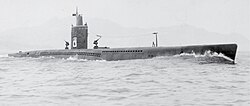I-201 class
|
Sen-Taka I-202 at full speed
|
||||||||||||||||
|
||||||||||||||||
|
||||||||||||||||
|
||||||||||||||||
|
||||||||||||||||
|
||||||||||||||||
The I-201 submarine class ( Japanese 伊 二 〇 一 型 潜水 艦 , I-Nihyakuichi-gata sensuikan ) was a submarine of the Imperial Japanese Navy during World War II . The ship was designed for maximum speed as a high-speed submarine ( 潜 高 型 Sentakagata or 潜 高 大型 Sentaka daigata , with daigata = "large version"). This Japanese name Sentaka also leads to the erroneous designation of the submarine class as "Sen-Taka", but actually only means fast submarine. Only the German test submarines with Walter drive were faster in World War II , but they did not reach operational readiness. The construction of the I-201, the type ship and namesake of the submarine class, began in 1943 at the naval shipyard in Kure . A total of eight boats were laid down, of which only I-201 , I-202 and I-203 were finished before the end of the war. None of the boats were used anymore.
construction
The class I-201 was ultimately Japan's attempt to reduce the enormous submarine losses from 1942 onwards. The speed of the new submarines should be able to evade the pursuers. Previous submarines became easier prey for the Allies thanks to the superior enemy radar technology and sonar . In October 1943, this led the Japanese Navy to demand at least 23 high-speed submarines (Sen taka) with the serial numbers Ship No. 4501-4523 . With the instruction No. 295 of October 29, 1943 to the naval design office, the key data of the design were set. The maximum underwater speed should be at least 25 kn and 20 kn should be possible over a longer period of time. This was not achieved.
The designers tried to achieve the goal as follows:
- Single hull boat as far as possible
- Install the ballast tank as high as possible to improve dynamic stability
- as streamlined as possible
- narrowest possible tower
- all deck guns were retractable and disappeared into lockable recesses during the dive.
- The upper deck had a smooth metal top and no more wooden walkways
- Snorkel facility.
- Omission of all superstructures, handles and brackets that are not absolutely necessary
- Use of battery cells with high capacity, but low life expectancy (less than 80 charging cycles)
Whereabouts
All three operational ships saw the end of the war and were delivered to the United States . I-201 and I-203 were transferred to Hawaii and analyzed by the US Navy. When the Soviet Union learned of the existence of the ships in the spring of 1946, they insisted on delivering a copy. To prevent this, the US Navy sank the ships during torpedo attempts in April / May 1946.
List of boats
| Construction no. | Surname | Shipyard | Keel laying | Launch | Commissioning | Decommissioning | comment |
|---|---|---|---|---|---|---|---|
| Version I-201 (Pr.S56 3 ) | |||||||
| 4501 | I-201 | Kure naval shipyard |
March 1, 1944 | July 22, 1944 | February 2, 1945 | November 30, 1945 | Sunk off Hawaii as the target ship of the USS Queenfish on May 23, 1946 |
| 4502 | I-202 | May 1, 1944 | September 2, 1944 | February 12, 1945 | November 30, 1945 | sunk by the US Navy off the Goto Islands on April 5, 1946 | |
| 4503 | I-203 | June 1, 1944 | September 20, 1944 | May 29, 1945 | November 30, 1945 | sunk as a target ship off Hawaii by the USS Caiman on May 21, 1946 | |
| 4504 | I-204 | August 1, 1944 | December 16, 1944 | 90% finished, sunk in an air raid on June 22, 1945, lifted and scrapped in Kure from February to May 1948 | |||
| 4505 | I-205 | September 4, 1944 | February 15, 1945 | 80% completed, sunk after an air raid on July 28, 1945, lifted and scrapped in Kure from May to August 1948 | |||
| 4506 | I-206 | October 27, 1944 | March 26, 1945 | 85% completed, construction halt on March 26, 1945, scrapped in Kure between October 1946 and January 1947 | |||
| Version I-207 (Pr.S56B) | |||||||
| 4507 | I-207 | Kure naval shipyard |
December 27, 1944 | 20% completed, construction stopped on April 17, 1945, scrapped in Kure between April and May 1946 | |||
| 4508 | I-208 | February 17, 1945 | 5% completed, construction stopped on April 17, 1945, scrapped in Kure between April and May 1946 | ||||
| 4509 to 4523 |
Boats no longer laid down | ||||||
Web links
Individual evidence
- ↑ Silence, Mark. Imperial Japanese Navy Submarines 1941–45 (Osprey, 2007), p. 38.
- ↑ USN GUPPY SUBMARINE CONVERSIONS 1947–1954 ( Memento of the original from October 15, 2013 in the Internet Archive ) Info: The archive link was inserted automatically and has not yet been checked. Please check the original and archive link according to the instructions and then remove this notice. , Internet resource for the Japanese I-200 class, accessed October 12, 2013
- ↑ Lengerer, p. 75

